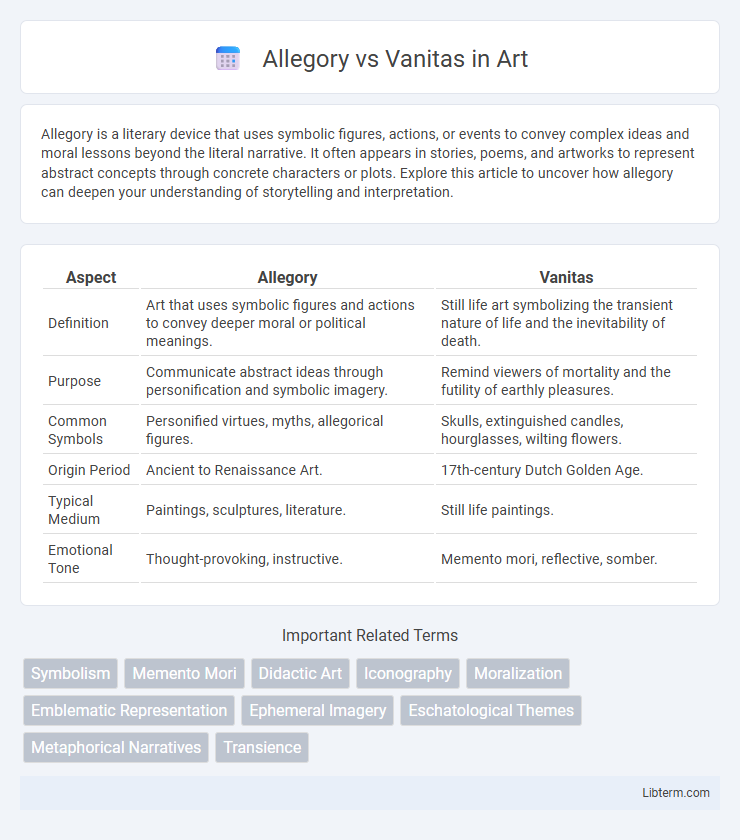Allegory is a literary device that uses symbolic figures, actions, or events to convey complex ideas and moral lessons beyond the literal narrative. It often appears in stories, poems, and artworks to represent abstract concepts through concrete characters or plots. Explore this article to uncover how allegory can deepen your understanding of storytelling and interpretation.
Table of Comparison
| Aspect | Allegory | Vanitas |
|---|---|---|
| Definition | Art that uses symbolic figures and actions to convey deeper moral or political meanings. | Still life art symbolizing the transient nature of life and the inevitability of death. |
| Purpose | Communicate abstract ideas through personification and symbolic imagery. | Remind viewers of mortality and the futility of earthly pleasures. |
| Common Symbols | Personified virtues, myths, allegorical figures. | Skulls, extinguished candles, hourglasses, wilting flowers. |
| Origin Period | Ancient to Renaissance Art. | 17th-century Dutch Golden Age. |
| Typical Medium | Paintings, sculptures, literature. | Still life paintings. |
| Emotional Tone | Thought-provoking, instructive. | Memento mori, reflective, somber. |
Understanding Allegory: Definition and Origins
Allegory is a literary and artistic device where characters, events, or symbols represent abstract ideas or moral qualities, originating from ancient Greek and Roman traditions. It serves as a narrative technique to convey complex messages through extended metaphorical storytelling, often found in religious, political, and philosophical contexts. Understanding allegory involves recognizing its layered meanings, where surface narratives reveal deeper symbolic interpretations beyond literal content.
Exploring Vanitas: Meaning and Historical Context
Vanitas is a symbolic genre of still-life painting that emerged in the 16th and 17th centuries, primarily in the Netherlands, emphasizing the transience of life, the futility of pleasure, and the certainty of death. Common Vanitas motifs include skulls, hourglasses, wilting flowers, and extinguished candles, all representing mortality and the fleeting nature of earthly achievements. This artistic tradition reflects the Baroque era's preoccupation with mortality and moral reflection, contrasting allegory's broader use of symbolic figures and narratives to convey abstract concepts.
Key Symbolisms in Allegory
Key symbolisms in allegory often include figures representing abstract concepts such as Justice, Truth, or Death, embodied through personification or symbolic objects like scales, mirrors, or skulls. These symbols convey deeper moral, philosophical, or spiritual meanings, guiding viewers to interpret the layered narrative beyond the literal depiction. Allegorical works rely heavily on cultural and historical contexts to encode complex messages within recognizable imagery.
Essential Symbols of Vanitas Art
Vanitas art essential symbols include skulls representing mortality, wilting flowers symbolizing the fleeting nature of life, and hourglasses or clocks indicating the passage of time. Other common motifs are extinguished candles signifying death, decaying fruit illustrating impermanence, and luxury items like jewelry or musical instruments highlighting vanity and ephemeral pleasures. These elements collectively remind viewers of life's transience and the futility of earthly pursuits.
Allegory vs Vanitas: Core Differences
Allegory and Vanitas are distinct artistic concepts with unique purposes; Allegory uses symbolic figures and narratives to convey abstract ideas or moral lessons, while Vanitas centers on the transient nature of life, often depicting mortality through objects like skulls and extinguished candles. Allegory encompasses a broader range of themes beyond mortality, serving as a complex symbolic representation in literature and visual arts. Vanitas, specifically rooted in the 16th and 17th-century still-life tradition, emphasizes the inevitability of death and the futility of earthly pleasures.
Common Themes Explored in Both Genres
Allegory and Vanitas both explore themes of mortality, the transient nature of life, and the futility of earthly pleasures. These genres use symbolic imagery, such as skulls, hourglasses, and decaying fruit, to emphasize the inevitability of death and moral reflection. Through visual metaphors, they prompt viewers to contemplate human existence, virtue, and the passage of time.
Artistic Techniques in Allegory and Vanitas
Allegory employs symbolic figures and extended narratives to convey moral or spiritual messages through layered visual metaphors, often utilizing personification and detailed iconography. Vanitas relies heavily on still life compositions featuring transient objects like skulls, hourglasses, and wilting flowers to emphasize life's impermanence, using meticulous realism and chiaroscuro to enhance the somber mood. Both genres leverage symbolism, but Allegory incorporates dynamic storytelling and complex character representations, while Vanitas focuses on detailed, static imagery to evoke contemplation on mortality.
Famous Works: Allegory and Vanitas Exemplars
Famous allegorical works such as Botticelli's "Primavera" embody complex symbolic themes representing mythological figures and abstract concepts like love and fertility. In contrast, Vanitas exemplars like Pieter Claesz's still lifes emphasize the transient nature of life through objects such as skulls, hourglasses, and wilting flowers, symbolizing mortality and the futility of earthly pleasures. These masterpieces serve as influential benchmarks in art history for exploring morality, existence, and human experience.
Cultural Impact of Allegory and Vanitas
Allegory and Vanitas both hold significant cultural impact by shaping artistic and philosophical reflections on morality and human existence. Allegory uses symbolic narratives to communicate complex moral and spiritual truths, influencing literature, religious art, and ethical discourse across cultures. Vanitas, a subgenre of still-life painting, culturally emphasizes the transient nature of life and material vanity, reinforcing existential contemplation and the value of spiritual over earthly pursuits.
Contemporary Interpretations and Relevance
Contemporary interpretations of allegory often emphasize its role in unpacking complex social and political narratives, while vanitas remains a poignant symbol of mortality and material transience in modern art. Artists today reinterpret vanitas motifs to critique consumer culture and environmental degradation, embedding traditional symbolism within contemporary contexts. This fusion underscores the enduring relevance of allegory and vanitas as tools for exploring existential themes and societal critique in 21st-century visual culture.
Allegory Infographic

 libterm.com
libterm.com